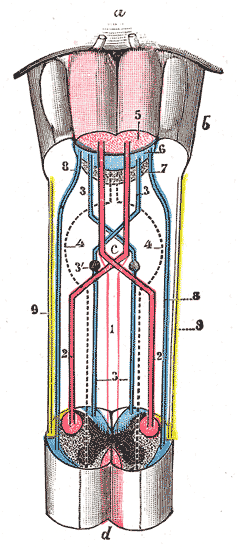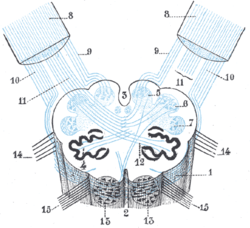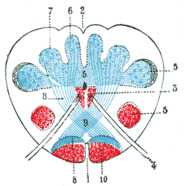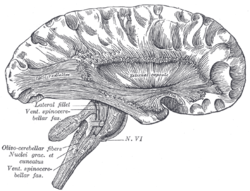Cuneate nucleus
| Cuneate nucleus | |
|---|---|
 Dissection of brain-stem. Dorsal view. (Label for "nucleus cuneatus" is on left, third from the bottom.) | |
 Section of the medulla oblongata at about the middle of the olive. | |
| Details | |
| Identifiers | |
| Latin | nucleus cuneatus |
| NeuroNames | hier-764 |
| NeuroLex ID | Cuneate nucleus |
| Dorlands /Elsevier | n_11/12580900 |
| TA | A14.1.04.206 |
| FMA | 68465 |
One of the dorsal column nuclei, the cuneate nucleus is a wedge-shaped nucleus in the closed part of the medulla oblongata. It contains cells that give rise to the cuneate tubercle, visible on the posterior aspect of the medulla. It lies laterally to the gracile nucleus and medial to the spinal trigeminal nucleus in the medulla.
Function
The cuneate nucleus is part of posterior column–medial lemniscus pathway, carrying fine touch and proprioceptive information from the upper body (above T6, except the face and ear—the information from the face and ear is carried by the primary sensory trigeminal nucleus) to the contralateral thalamus via the medial lemniscus.
Inputs
It receives direct input from the mechanoreceptors of the upper body as well as indirect input from them via the spinal cord. It is also subject to descending control from the central nervous system.
Pathology
It may be affected by vitamin E deficiency exhibiting neuroaxonal swelling.
See also
Additional images
 Decussation of pyramids.
Decussation of pyramids. Dissection of brain-stem. Lateral view.
Dissection of brain-stem. Lateral view. Deep dissection of brain-stem. Lateral view.
Deep dissection of brain-stem. Lateral view. Superior terminations of the posterior fasciculi of the medulla spinalis.
Superior terminations of the posterior fasciculi of the medulla spinalis. Diagram showing the course of the arcuate fibers.
Diagram showing the course of the arcuate fibers. The formatio reticularis of the medulla oblongata, shown by a transverse section passing through the middle of the olive.
The formatio reticularis of the medulla oblongata, shown by a transverse section passing through the middle of the olive. Scheme showing the course of the fibers of the lemniscus; medial lemniscus in blue, lateral in red.
Scheme showing the course of the fibers of the lemniscus; medial lemniscus in blue, lateral in red. Transverse section passing through the sensory decussation.
Transverse section passing through the sensory decussation. Deep dissection of cortex and brain-stem.
Deep dissection of cortex and brain-stem. The sensory tract.
The sensory tract.- Fourth ventricle.Posterior view.Deep dissection.
External links
- Stained brain slice images which include the "Cuneate nucleus" at the BrainMaps project
- NIF Search - Cuneate Nucleus via the Neuroscience Information Framework